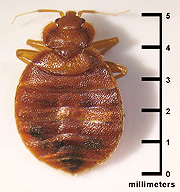Neuroscience For Kids
 When the Treatment is a Bad as the Problem
When the Treatment is a Bad as the Problem
Insecticides for Bed Bugs Making People Sick
October 4, 2011
Bed bugs (Cimex lectularius) have been a problem for people as long as people have had beds. Although bed bugs do not spread disease, they can cause skin problems when they feed on blood. In the mid-1900s, the use of the chemical DDT to kill bed bugs reduced the problem significantly. However, since DDT has been banned because it is toxic, bed bugs are on the rise again.
Some people have turned to other insecticides to control bed bugs. When insecticides are not used properly, they can be worse than the problem. In fact, researchers identified 111 illnesses between 2003 and 2010 that were associated with insecticides used to fight bed bugs. Of the 111 illnesses, 99 (89%) of them were caused by chemicals called pyrethroids or pyrethrins.
 Pyrethrins are natural chemicals found in the chrysanthemum plant.
(Pyrethroids are synthetic versions of pyrethrins.) Pyrethrins and
pyrethroids are neurotoxins. These chemicals work by keeping sodium channels in nerve axons open. Because the
neuron cannot repolarize, the nerve stops working and paralysis sets in.
Pyrethrins are natural chemicals found in the chrysanthemum plant.
(Pyrethroids are synthetic versions of pyrethrins.) Pyrethrins and
pyrethroids are neurotoxins. These chemicals work by keeping sodium channels in nerve axons open. Because the
neuron cannot repolarize, the nerve stops working and paralysis sets in.
Although low pyrethrins and pyrethroids are thought to be
somewhat safe for people, high doses can cause health issues. Most (81%)
of the 111 illnesses related to bed bug insecticide use were minor, but
one person died. The most common misuses of insecticides were using too
much of the chemical, not washing or changing bedding that was treated
with chemicals, and not telling people that chemicals had been applied to
an area.
Common symptoms of exposure to these pesticides included headaches, dizziness, breathing problems, nausea and vomiting. The one person who died, a 65 year old woman with a history of health problems, had her husband spray one insecticide inside their house and another to their bed. They also used 9 cans of an insecticide fogger in their home. To make matters worse, two days later, they reapplied chemicals to the bed and used another nine cans of insecticide fogger. The woman even applied bed bug and flea insecticide directly on her arms, chest and hair. Two days after the last exposure, the woman was found unresponsive and died in the hospital nine days later.
 These
cases show that it is always important to READ THE LABEL before
you use any pesticide and follow the directions. Also, make sure that the
chemical is made for the problem you are trying to control. Of course,
you could leave your bed bug problems to a trained, licensed pest control
professional.
These
cases show that it is always important to READ THE LABEL before
you use any pesticide and follow the directions. Also, make sure that the
chemical is made for the problem you are trying to control. Of course,
you could leave your bed bug problems to a trained, licensed pest control
professional.
References and more information:
- Jacobson et al., Acute Illnesses Associated With Insecticides Used to Control Bed Bugs --- Seven States, 2003-2010, Morbidity and Mortality Weekly Report (MMWR), September 23, 2011 / 60(37);1269-1274
- Bed Bugs - Environmental Protection Agency
- National Bed Bug Summit
Copyright © 1996-2011, Eric H. Chudler, University of Washington
